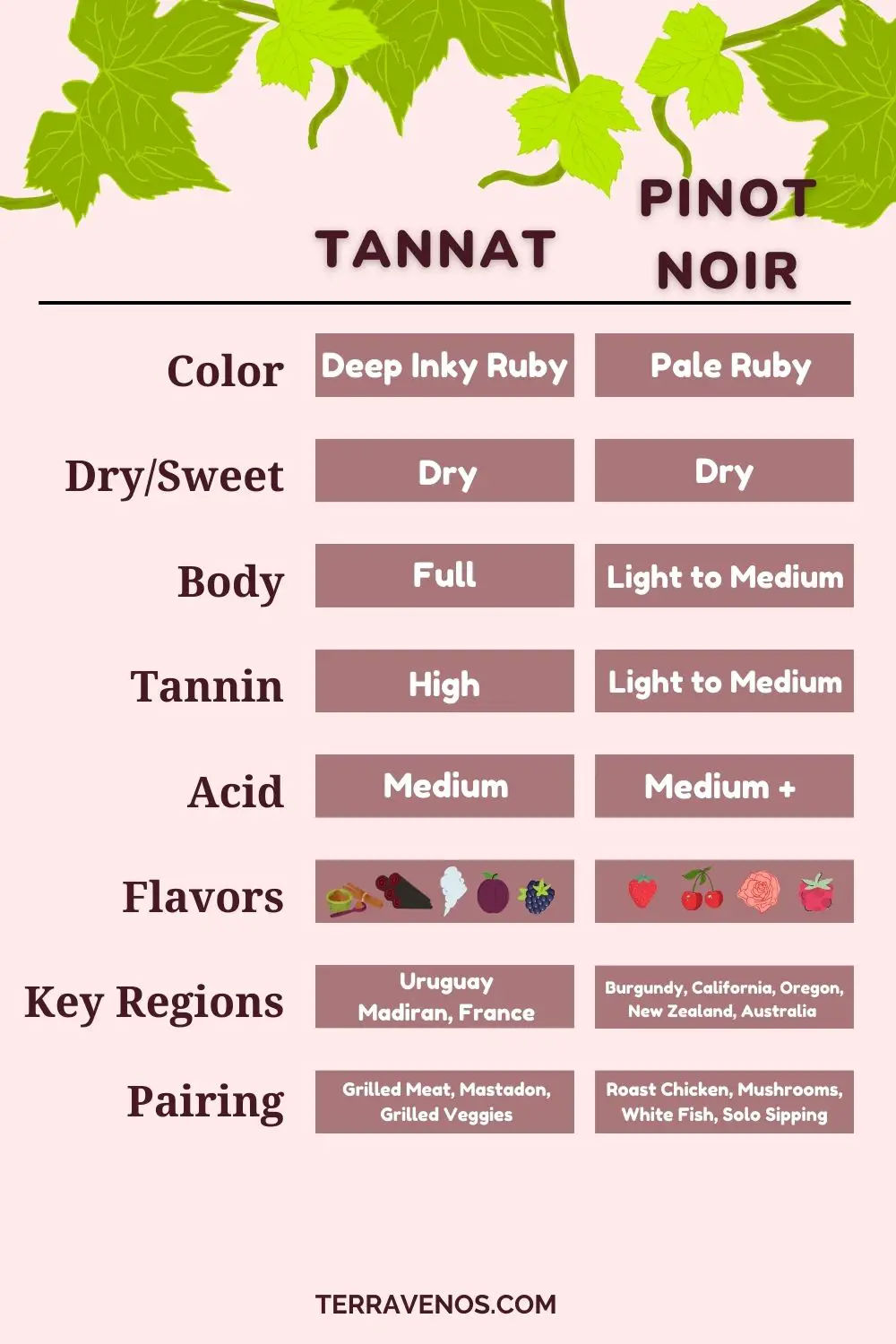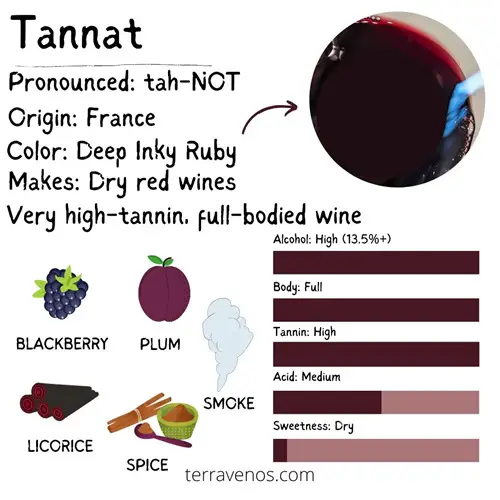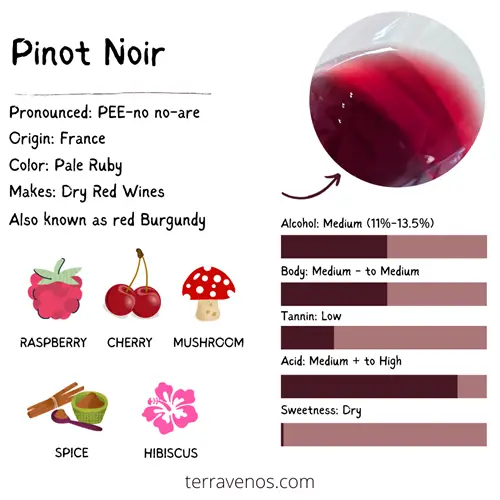
Comparing Tannat vs Pinot Noir is an intriguing side-by-side comparison.
Tannat has more color, tannin, and body than Pinot Noir. Tannat is black-fruited; Pinot Noir has red fruit, higher acid, and a lighter body.
TL;DR: If you like the bright, friendly nature of Pinot Noir, you probably won’t care for Tannat.
Tannat Basics: A Powerful Red

Tannat, from the Madiran region of southwestern France, is a powerful, tannic red wine grape that isn’t nearly as popular as some of the other big reds out there. Today, Tannat’s spiritual home is Uruguay, of all places, in a curious twist of wine fate. (Here’s a deep Tannat wines.)
You’ll find tiny pockets of Tannat grown outside of France and Uruguay from boutique producers. If you come across these wines, be sure to give them a try.
Wines from tannat are deeply colored, almost an inky-black, thanks to thick skins and small berries. Those skins leach out tannins into the wine, making for an astringent drinking experience. Tannat showcases black fruit, licorice, spice, and a smokey note.
Fun Wine Fact: The name “Tannat” derives from tannin, giving you a clue as to just how tannic this wine can be.
Pinot Noir Basics: Red Burgundy

Pinot Noir is originally from the Burgundy region of France and today you’ll find wines made from Pinot Noir made around the world, including Oregon, California, Chile, New Zealand, and Australia. Pinot Noir is an aromatic red wine grape known for its red cherry and cranberry aromas, along with a floral profile. (Check out this comprehensive guide to Pinot Noir wines.)
Fun Wine Fact: Pinot Noir can go be Red Burgundy. If you ask for a Red Burgundy at a restaurant or wine shop, you’ll get a Pinot Noir.
Wine Comparison: Tannat vs. Pinot Noir
Here’s a quick side-by-side that covers the most common styles of Tannat and Pinot Noir.
| Characteristics | Tannat | Pinot Noir |
|---|---|---|
| Hue | Deep purple to inky black | Pale ruby |
| Color | Red | Red |
| Aromas | Dark fruit, chocolate, black tea, licorice, smoke | Red cherry, red currant, wet leaf, spice, mushroom |
| Tannins | Very High | Low to medium minus |
| Acid | Medium | Medium to Medium Plus |
| Alcohol (%) | 13-15% | 12%-14% |
| Body | Full | Medium minus to medium |
| Intensity | Pronounced | Medium plus to pronounced |
| Blending | Blended to soften | Blending uncommon |
| Key Growing Regions | Uruguay (Madiran, Tursan in France) | Burgundy (France), Oregon, Sonoma and Coastal California, Chile, New Zealand, Australia |
| Classic Pairings | Grilled meats, hearty stews | Cream sauces, risottos, white meat |
| Price Range | $15-$40 | $10-$80+ |
Tannat Wine Profile:
- Sweetness: Tannat is a dry red wine.
- Alcohol: Tannat wines generally have a moderate to high alcohol content, ranging from around 13% to 15% ABV.
- Body: Known for its bold body, Tannat provides a powerful and complex drinking experience.
- Tannins: Tannat has higher tannin levels compared to Pinot Noir
- Acid: Tannat has medium acid levels, similar to or slightly less than Pinot Noir
- Flavor and Aromas Intensity: Tannat will be medium plus to pronounced on the nose and palate with dark fruits, like blackberry and black plum, dark chocolate, licorice, and smoke.
Personal Note: I have Tannat wines in my cellar, but these are not wines for new wine drinkers. These are adult wines.
Pinot Noir Wine Profile
- Sweetness: Pinot Noir is almost always made in a dry style unless it is an inexpensive bulk wine
- Alcohol: Pinot Noir wines typically feature moderate alcohol content, a little less than Tannat wines, around 12%-14% ABV
- Acid: Pinot Noir tends to have medium to medium (+) acid, maybe a little higher than Tannat.
- Body: Pinot Noir is lighter in body than Tannat, medium or medium (-)
- Tannins: Pinot Noir tends to have low to medium tannins that are very smooth and much less pronounced than Tannat wine.
- Flavor: Vibrant red fruit flavors like cranberry, raspberry, and red cherry, accompanied by floral notes and sometimes even a wet earth and tea leaf.
Helpful Tip: Both Tannat and Pinot Noir are often oaked during winemaking. Here’s what oak contributes to wine.
Are Tannat and Pinot Noir Similar?
Both Tannat and Pinot Noir are red wines with medium acid. Both wines are often oaked, with mocha, spice, coffee, and cocoa notes.
What Is the Difference Between Tannat and Pinot Noir?
Tannat will have much stronger tannins than Pinot Noir. Tannat has black fruit (like blackberry and currant); Pinot Noir has red fruit (like raspberry and cherry).
Tannat vs. Pinot Noir: Food Pairings and Serving Temperature

Tannat Food Pairing: Tannat’s savory and dark fruit flavors make it a versatile companion for a variety of dishes, including grilled meats and stews. This is a wine you’ll want to pair with protein and fat.
Pinot Noir is a more delicate wine with nuanced red cherry flavors. Look to dishes that can use a little brightening up, like risotto, salads, and roasted white meats.
Both Tannat and Pinot Noir are best enjoyed at slightly below room temperature. Place them in a cool, dark place 10-15 minutes before serving.
Discover More:
Pinot Noir Cheese Pairing Guide
Which Is More Expensive, Tannat vs. Pinot Noir?

Pinot Noir and Tannat do have an overlapping price-point, but Tannat wines won’t be as widely available depending on where you live in the world. Tannat just doesn’t share Pinot Noir’s fame and wide-spread cultivation.
Tannat Cost
Entry-level Tannat wines are typically affordable, ranging from $15 to $20 per bottle.
If you are looking for premium Tannat, there are higher-priced Tannat wines available. These bottles, priced around $25 to $40 or higher, offer a more complex and nuanced drinking experience.
Pinot Noir Cost
Pinot Noir wines are widely available at various price points. You’ll find budget-friendly Pinot Noir starting around $5 USD. These wines, while more affordable, are typically made in an off-dry (slightly sweet) style.
Pinot Noir starts to get interesting around $18-$25 USD. Premium Pinot Noir wines, sourced from renowned regions, can easily cost you $45 – $80+ USD.
Which Is Better Tannat or Pinot Noir?
If you enjoy bold, robust red wine with dark fruit, smoke, and tannin, Tannat will be better for you. If you prefer soft, bright red-fruit-forward wines, then Pinot Noir is the better option. If you’re going to sip your wine without food, then Pinot Noir is the better wine.
Final Thoughts – Tannat or Pinot Noir?
Both Tannat and Pinot Noir are very different wines. One is a tannic monster, the other a lovely, perfumed incarnation of the grape.
I’m a big fan of side-by-side tastings to tease out the profiles of different wines. A great way to get started with these two wines is to do a side-by-side comparison.
Grab 2 bottles of similarly priced Tannat and Pinot Noir. Invite over a few friends and enjoy an evening of swirling and sipping.
Helpful Tip 1: Tannat is a food wine. Make sure you have something to nibble while you’re tasting it.
Helpful Tip 2: Taste the Pinot Noir first, the Tannat second. Here’s a post on what order to taste your wines. Super helpful.
Thirsty for More?
I’m a big believer in doing side-by-side tastings to boost your wine knowledge. Here’s how to host your own wine tasting for beginners.
Check out this post on Cabernet Sauvignon vs Merlot, another popular red wine, along with Cabernet Sauvignon vs Malbec, and Shiraz vs Merlot.
You should be able to find delicious wines at every price point. Check out this post on how to find great wines under $50.




